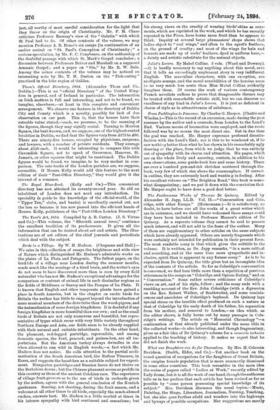Birds in a Village. By W. H. Hudson. (Chapman and
Hall.)— We miss in this collection of essays the brightness and wide view of Nature which distinguished Mr. Hudson's admirable works on the plains of La Plata and Patagonia. The fullest paper, on the bird-life of a village near London during the summer months, reads much like the musings of a tired brain, and the writer's eyes do not seem to have discovered more than is seen by every field naturalist who has not Mr. Hudson's exceptional advantages for the comparison or contrast of animal life in such dissimilar regions as the fields of Middlesex or Surrey and the Pampas of La Plata. It is known that English and other temperate plants have gained a place in South America, but in the chapter on exotic birds for Britain the author has little to suggest beyond the introduction of more musical members of the dove tribe than the wood-pigeon, and the naturalisation of some foreign kingfishers. It is doubtful if any foreign kingfisher is more beautiful than our own ; and as the small birds of Britain are not only numerous and beautiful, but repre- sentative of types which recur with very little variety throughout Northern Europe and Asia, our fields seem to be already supplied with their natural and suitable inhabitants. On the other hand, the pheasant, red-legged partridge, capercailzie, and among domestic species, the fowl, peacock, and guinea-hen, are all im- portations. But the American turkey always dwindles in size when allowed to rim wild in English woods,—a fact which Mr. Hudson does not notice. He calls attention to the partial accli- matisation of the South American bird, the Rufous Tinamou, in Essex, and suggests the hazel-hen as a suitable subject for experi- ment. Hungarian partridges and Russian hares do not thrive on the Berkshire downs ; but the Chinese pheasant seems as prolific in this country as those of the ancient Colchian race. The experience of village fruit-growers as to the use of birds in orchards given by the author, agrees with the general conclusion of the Kentish gardeners. Scaring, not shooting, during the fruit season, and a welcome at all other times to all birds, especially the much-abused cuckoo, answers best. Mr. Hudson is a little morbid at times in his intense sympathy with bird sentiment and sensations; but his strong views on the cruelty of wearing birds'-skins as orna- ments, which are reprinted in the work, and which he has recently repeated in the Times, have borne more fruit than he appears to think. Inquiry at several large pinmaasiers' shops shows that ladies object to "real wings," and often to the egret's feathers, on the ground of cruelty ; and most of the wings for hats and bonnets are made up of cocks' feathers, dyed in uniform hues,— a dainty and artistic substitute for the natural objects.


































 Previous page
Previous page